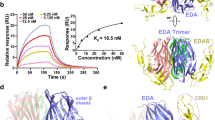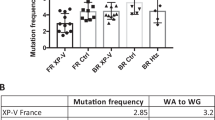Abstract
The gene that encodes nuclear factor κ (NF-κB) essential modulator (or NEMO, also known as IKKγ) is required for activation of the transcription factor NF-κB. We describe mutations in the puta-tive zinc-finger domain of NEMO that result in an X-linked primary immunodeficiency characterized by hyper-IgM syndrome and hypohydrotic ectodermal dysplasia (XHM-ED). These mutations prevent CD40 ligand (CD40L)-mediated degradation of inhibitor of NF-κB α (IκB-α) and account for the following observations: B cells from XHM-ED patients are unable to undergo immunoglobulin class-switch recombination and antigen-presenting cells (APCs) are unable to synthesize the NF-κB–regulated cytokines interleukin 12 (IL-12) or tumor necrosis factor α (TNF-α) when stimulated with CD40L. Nevertheless, innate immunity is preserved in XHM-ED patients because APCs retain the capacity to respond to stimulation by lipopolysaccharide or Staphylococcus aureus Cowan's antigen (SAC). Overall, the phenotype observed in XHM-ED patients shows that the putative zinc-finger domain of NEMO has a regulatory function and demonstrates the definite requirement of CD40-mediated NF-κB activation for B cell immunoglobulin class-switching.
This is a preview of subscription content, access via your institution
Access options
Subscribe to this journal
Receive 12 print issues and online access
$209.00 per year
only $17.42 per issue
Buy this article
- Purchase on Springer Link
- Instant access to full article PDF
Prices may be subject to local taxes which are calculated during checkout





Similar content being viewed by others
References
Callard, R. E., Armitage, R. J., Fanslow, W. C. & Spriggs, M. K. CD40 ligand and its role in X-linked hyper-IgM syndrome. Immunol. Today 14, 559–564 (1993).
Notarangelo, L. D., Duse, M. & Ugazio, A. G. Immunodeficiency with hyper-IgM (HIM). Immunodef. Rev. 3, 101–121 (1992).
Kroczek, R. A. et al. Defective expression of CD40 ligand on T cells causes “X-linked immunodeficiency with hyper-IgM (HIGM1)”. Immunol. Rev. 138, 39–59 (1994).
DiSanto, J. P., Bonnefoy, J. Y., Gauchat, J. F., Fischer, A. & de Saint Basile, G. CD40 ligand mutations in x-linked immunodeficiency with hyper-IgM. Nature 361, 541–543 (1993).
Han, S. et al. Cellular interaction in germinal centers. Roles of CD40 ligand and B7-2 in established germinal centers. J. Immunol. 155, 556–567 (1995).
Xu, J. et al. Mice deficient for the CD40 ligand. Immunity 1, 423–431 (1994).
Renshaw, B. R. et al. Humoral immune responses in CD40 ligand-deficient mice. J. Exp. Med. 180, 1889–1900 (1994).
Allen, R. C. et al. CD40 ligand gene defects responsible for X-linked hyper-IgM syndrome. Science 259, 990–993 (1993).
Jain, A. et al. Defects of T-cell effector function and post-thymic maturation in X- linked hyper-IgM syndrome. J. Clin. Invest. 103, 1151–1158 (1999).
Monreal, A. W. et al. Mutations in the human homologue of mouse dl cause autosomal recessive and dominant hypohidrotic ectodermal dysplasia. Nature Genet. 22, 366–369 (1999).
Kere, J. et al. X-linked anhidrotic (hypohidrotic) ectodermal dysplasia is caused by mutation in a novel transmembrane protein. Nature Genet. 13, 409–416 (1996).
Jin, D. Y. & Jeang, K. T. Isolation of full-length cDNA and chromosomal localization of human NF-κB modulator NEMO to Xq28. J. Biomed. Sci. 6, 115–120 (1999).
Yamaoka, S. et al. Complementation cloning of NEMO, a component of the IκB kinase complex essential for NF-κB activation. Cell 93, 1231–1240 (1998).
Israel, A. The IKK complex: an integrator of all signals that activate NF-κB? Trends Cell. Biol. 10, 129–133 (2000).
Ghosh, S., May, M. J. & Kopp, E. B. NF-κB and Rel proteins: evolutionarily conserved mediators of immune responses. Annu. Rev. Immunol. 16, 225–260 (1998).
Maniatis, T. A ubiquitin ligase complex essential for the NF-κB, Wnt/Wingless, and Hedgehog signaling pathways. Genes Dev. 13, 505–510 (1999).
Smahi, A. et al. Genomic rearrangement in NEMO impairs NF-κB activation and is a cause of incontinentia pigmenti. The International Incontinentia Pigmenti (IP) Consortium. Nature 405, 466–472 (2000).
Zonana, J. et al. A Novel X-Linked Disorder of Immune Deficiency and Hypohidrotic Ectodermal Dysplasia Is Allelic to Incontinentia Pigmenti and Due to Mutations in IKK-γ (NEMO). Am. J. Hum. Genet. 67 (2000).
Aderem, A. & Ulevitch, R. J. Toll-like receptors in the induction of the innate immune response. Nature 406, 782–787 (2000).
Abbas, A. A., Licthman, A. H. & Prober, J. S. Cellular and Molecular Immunology. (Saunders, Philadelphia, 1998).
Klein, U., Rajewsky, K. & Kuppers, R. Human immunoglobulin (Ig)M+IgD+ peripheral blood B cells expressing the CD27 cell surface antigen carry somatically mutated variable region genes: CD27 as a general marker for somatically mutated (memory) B cells. J. Exp. Med. 188, 1679–1689 (1998).
Grewal, I. S. & Flavell, R. A. CD40 and CD154 in cell-mediated immunity. Annu. Rev. Immunol. 16, 111–135 (1998).
Grammer, A. C. et al. TNF receptor-associated factor-3 signaling mediates activation of p38 and Jun N-terminal kinase, cytokine secretion, and Ig production following ligation of CD40 on human B cells. J. Immunol. 161, 1183–1193 (1998).
Sutherland, C. L., Heath, A. W., Pelech, S. L., Young, P. R. & Gold, M. R. Differential activation of the ERK, JNK, and p38 mitogen-activated protein kinases by CD40 and the B cell antigen receptor. J. Immunol. 157, 3381–3390 (1996).
Shu, U. et al. Activated T cells induce interleukin-12 production by monocytes via CD40-CD40 ligand interaction. Eur. J. Immunol. 25, 1125–1128 (1995).
Medzhitov, R., Preston-Hurlburt, P. & Janeway, C. A. Jr A human homologue of the Drosophila Toll protein signals activation of adaptive immunity. Nature 388, 394–397 (1997).
Yan, M. et al. Two-amino acid molecular switch in an epithelial morphogen that regulates binding to two distinct receptors. Science 290, 523–527 (2000).
Lomaga, M. A. et al. TRAF6 deficiency results in osteopetrosis and defective interleukin-1, CD40, and LPS signaling. Genes Dev. 13, 1015–1024 (1999).
Naito, A. et al. Severe osteopetrosis, defective interleukin-1 signalling and lymph node organogenesis in TRAF6-deficient mice. Genes Cells 4, 353–362 (1999).
Deng, L. et al. Activation of the IκB kinase complex by TRAF6 requires a dimeric ubiquitin-conjugating enzyme complex and a unique polyubiquitin chain. Cell 103, 351–361 (2000).
Acknowledgements
We thank the families studied for their invaluable contribution to this project; R. Dhanasekaran for technical assistance; V. Dixit (Genentech), J. Derry and W. Fanslow (Immunex), P. Lipsky, A. Grammer and K. Brown for helpful discussions; and U. Seibenlist for critical review of the manuscript. Supported by the Immune Deficiency Foundation and the National Foundation of Ectodermal Dysplasia
Author information
Authors and Affiliations
Corresponding author
Rights and permissions
About this article
Cite this article
Jain, A., Ma, C., Liu, S. et al. Specific missense mutations in NEMO result in hyper-IgM syndrome with hypohydrotic ectodermal dysplasia. Nat Immunol 2, 223–228 (2001). https://doi.org/10.1038/85277
Received:
Accepted:
Issue Date:
DOI: https://doi.org/10.1038/85277
This article is cited by
-
Compound heterozygous WNT10A missense variations exacerbated the tooth agenesis caused by hypohidrotic ectodermal dysplasia
BMC Oral Health (2024)
-
Targeting NF-κB pathway for the therapy of diseases: mechanism and clinical study
Signal Transduction and Targeted Therapy (2020)
-
Regulation of B-cell function by NF-kappaB c-Rel in health and disease
Cellular and Molecular Life Sciences (2020)
-
T Cell Impairment Is Predictive for a Severe Clinical Course in NEMO Deficiency
Journal of Clinical Immunology (2020)
-
Respiratory Complications in Patients with Hyper IgM Syndrome
Journal of Clinical Immunology (2019)



